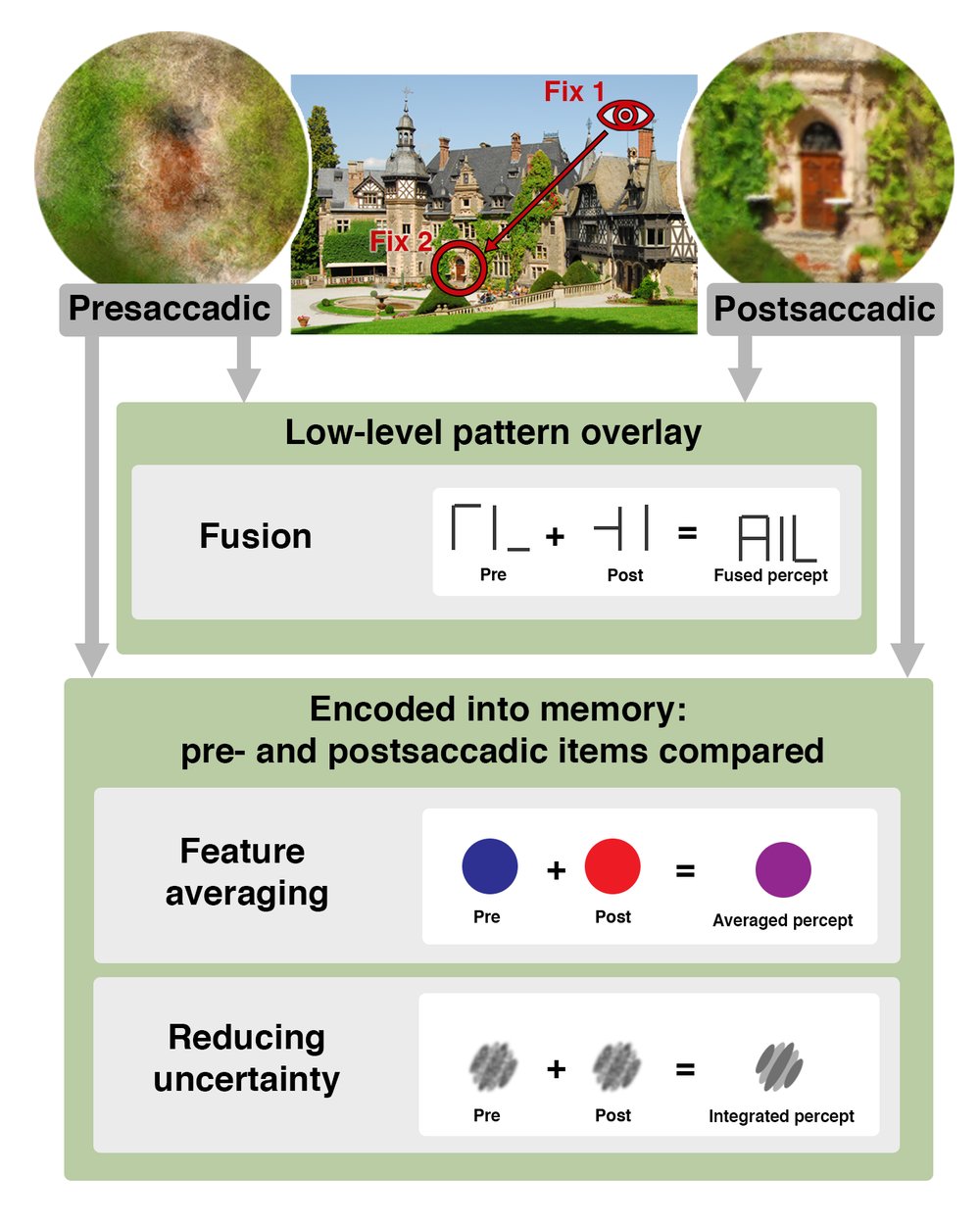Transsaccadic perception
Humans make 2-3 saccades per second, bringing areas and objects of interest under foveal scrutiny. The presaccadic views of these objects and areas are subject to the limitations of peripheral vision, causing a crowded, low-resolution view of these areas; the postsaccadic view in contrast provides a clear-high resolution counterpart.
How does the visual system deal with this discontinuity with every saccade?
How do we maintain a stable perception of the enivornment, despite these constant changes in retinal input?
One mechanism that may account for this is transsaccadic integration. By this account, both the features and reliability of pre- and postsaccadic objects can be combined to result in a more reliable, averaged transsaccidc object representation.

Transsaccadic integration
We have studied a number of aspects of transsaccadic integration – for a comprehensive review of this (and other interactions between peripheral and foveal vision), see the following paper:
Stewart, E.E.M., Valsecchi, M., & Schütz, A.C. (2020). A review of interactions between peripheral and foveal vision. Journal of Vision, 20(12), 2. PDF
Mechanisms underlying transsaccadic integration
We were particularly interested in studying optimal transsaccadic integration in a maximum liklihood estimation framework. Transsaccadic integration has been shown to follow optimal MLE integration (i.e. Wolf & Schütz, 2015), where the reliability of the transsaccadic stimulus is equal to the summed reliability of the pre- and postsaccadic stimuli. We used this framework to investigate the mechanisms underlying transaccadic integration:
Attention. By showing a distractor around the time of the saccade, we saw a deviation from optimal integration, suggesting attention is required for optimal integration (of orientation) to occur:
Stewart, E.E.M., & Schütz, A.C. (2018). Attention modulates trans-saccadic integration. Vision research, 142, 1-10. PDF
Memory. In a similar vein, by introducing memory load before the saccade, we also saw a deviation from optimal integration (of colour), suggesting that visual working memory is required for optimal integration:
Stewart, E.E.M., & Schütz, A.C. (2018). Optimal trans-saccadic integration relies on visual working memory. Vision research, 153, 70-81. PDF
Spatiotemporal properties of integration
Is transsaccadic integration specific to the saccade target? By testing integration across the visual field, we showed that while integration (of orientation) is strongest at the saccade target, it can occur at attended, task-relevent locations across the visual field:
Stewart, E.E.M., & Schütz, A.C. (2019). Transsaccadic integration benefits are not limited to the saccade target. Journal of neurophysiology, 122 (4), 1491-1501. PDF
We also showed that integration (of orientation) is spatiotopic, not retinotopic, can transfer across hemifields, and can occur even when the stimulus is shown for a very brief time pre- and postsaccadically. Crucially, we also show that integration benefits are greater than you would get if you assume that integration is just a “temporal summation” of pre- and postsaccadic information:
Stewart, E.E.M., & Schütz, A.C. (2019). Trans-saccadic integration is dominated by early, independent noise. Journal of Vision, 19(6):17. PDF
Development of saccadic suppression of displacement
How do we learn about our own saccadic uncertainty, and how does our visual system learn to compensate for this?
In this paper we tested children ages 7-12 and showed that they had greater variability in their saccade endpoints that adults, but were also faster to make corrective saccades. They also showed stronger saccadic suppression of displacement and blanking effect. Together, these results suggest that children may have a greater internal expectation or prediction of saccade error than adults; thus, the stronger SSD in children may be due to higher intrinsic uncertainty in target localization or saccade execution.
Stewart, E.E.M., Hübner, C., & Schütz, A.C. (2020). Stronger saccadic suppression of displacement and blanking effect in children. Journal of Vision, 20(10), 13. PDF